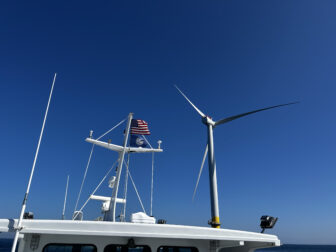The impacts of climate change are already apparent in Hampton Roads. The state’s vulnerable coastline continually floods communities, impacting the lives of hundreds of thousands of people throughout the region. Coastal residents are eager to learn and act on solutions to protect the communities they love from the rising tides. On Tuesday, December 2, nearly sixty people came out to CCAN’s “Save Our Coast” town hall and book event to do just this.
Folks who attended the event first heard from Stephen Nash, author of Virginia Climate Fever. Nash spoke about the impacts of climate change on Virginia’s communities and the drastic need for clean energy solutions throughout the state. He warned that the average temperature in the state is on the rise, and Virginia could see double the amount of about 90ºF days by 2065. The first ten months of 2014 have been the hottest on record, since temperature monitoring began around 130 years ago.
Hampton Roads has it much worse though. The region stands as the most vulnerable climate impact zone in Virginia and could see triple the amount of 90ºF days by 2065 – a threat to their beloved ecosystems and public health alike. Even more frightening is the fact that the rate of sea level rise is accelerating along the state’s coast, and it’s already at the doorsteps of thousands of residents. Much of the development in Hampton Roads rests on subsiding land, putting the region at risk for higher rates of sea level rise than will be seen elsewhere along the Atlantic Coast.
This scale of climate disruption does not have to become a reality though, as Virginians can still take action to curtail its greenhouse gas emissions. Nash explained that Virginia can still make the switch to renewable energy at a fast pace to lessen the impacts of climate change on the state. If Virginia acts now to curtail its greenhouse gas emissions, the rate and extent of relative sea level rise will be significantly less than it will be if the state continues to ground its energy consumption on fossil fuels.
One person in the audience asked Nash what the most important thing to be done is. He proceeded to say that taking part in the public conversation is the most important thing for people to do if change is to occur. Mike Tidwell, CCAN’s Executive Director, also answered this question. His response, to which Nash conceded, was for the state to pass the Virginia Coastal Protection Act that would commit the state to the Regional Greenhouse Gas Initiative (RGGI).
Dawone Robinson, CCAN’S Virginia Policy Director, went on to explain the Virginia Coastal Protection Act and RGGI to coastal residents, activists and students alike who gathered for the town hall. RGGI is a cooperative effort between nine states that caps carbon pollution from power plants while requiring them to purchase allowances for every ton of carbon pollution they emit in a given year. By committing to RGGI, the state of Virginia could see over $200 million in revenue by 2020. This revenue would then be appropriated as follows: (1) 50% to Hampton Roads for coastal adaptation efforts; (2) 35% to statewide energy efficiency and clean energy programs; (3) 10% to southwest Virginia for economic development assistance; and (4) 5% to RGGI for programmatic expenses.
Nash and Tidwell both touched on the difficulty of passing bills that support clean energy in Virginia’s legislature. Dominion, the state’s largest energy provider, is highly engrained in the state’s politics, often leaving the statehouse polarized on issues. However, the circumstances for reducing fossil fuel emissions in Virginia have changed radically with the EPA’s Clean Power Plan Rules that will be finalized next summer. The Clean Power Plan is calling on Virginia to reduce its carbon emissions by 38% by 2030, and RGGI stands as the best mechanism for the state to meet its emissions reduction goals while providing funding for essential climate adaptation, mitigation and sustainable development measures across specified regions of the state.
 So what is the most important thing that needs to be accomplished to lessen the impacts of global climate change on Virginians? How can people on the ground help to push for climate solutions that will alleviate the sea level rise impacts that coastal Virginians are facing now, while protecting the future livelihoods of citizens across the state? Each of the featured panelists had a similar position on this question, which was asked by a dedicated activist who attended the town hall and book event. The answer? Get out there and join the public conversation. Talk to your friends, family members, acquaintances, and anyone else you can about bringing climate solutions to the state.
So what is the most important thing that needs to be accomplished to lessen the impacts of global climate change on Virginians? How can people on the ground help to push for climate solutions that will alleviate the sea level rise impacts that coastal Virginians are facing now, while protecting the future livelihoods of citizens across the state? Each of the featured panelists had a similar position on this question, which was asked by a dedicated activist who attended the town hall and book event. The answer? Get out there and join the public conversation. Talk to your friends, family members, acquaintances, and anyone else you can about bringing climate solutions to the state.
Teresa Stanley of Virginia Organizing, the first panelist that the group heard from on Tuesday night, spoke about the importance of collective action to make climate solutions a reality for the state. Communities need to be informed of the risks that Virginia faces under climate change, and communities need to be further mobilized to ensure that the state’s precious neighborhoods, culture and landscapes are protected from the projected devastating impacts.
Quan Williams of Virginia New Majority, the event’s second panelist, said that for her, the most important thing is to get the Virginia Coastal Protection Act passed. Climate change is an issue that know no races, borders, or classes. It will affect us all. And for many of us, climate change is a phenomenon that is capable of presenting itself in life or death situations. We must start acting now, together, to take charge of state initiatives that will turn the tide in the people’s favor.
The last panelist, Dr. Michelle Covi of Old Dominion University, spoke of planning and infrastructure initiatives that need to be updated to best prepare for sea level rise and climate change impacts along the state’s coast, home to the largest naval station in the world. Dramatic storm events are no longer the only driver on flooding in Hampton Roads; heavy downpours and high tides are now of high concern for flooding as well. Municipalities in Hampton Roads need to start working now to improve the resiliency of their highly prized social fabric. Evacuation routes need to be readjusted to include transportation to low-income neighborhoods and houses need to be raised to fight recurrent flooding.
But all of this will come at a cost. Improving infrastructure in Hampton Roads to combat the extensive occurrence of flooding that the region already experiences will need funding to occur, and fast. This is a problem that each and every single municipality in coastal Virginia is facing, and their solution may come sooner than expected. That is if the Virginia Coastal Protection Act passes. In a regular year, CCAN would not dream of getting this bill passed in such a short amount of time. But the fact is that the playing field has changed in Virginia.
The EPA’s Clean Power Plan will be finalized in the summer of 2015, and the state will need to cut 38% of its emissions by 2030. No matter what, the state will need to curb its carbon pollution, and the best option for Virginia is to get ahead of the game and start generating revenue by capping emissions. CCAN has already collected hundreds of petitions to support the Coastal Protection Act and is working to organize communities in support of the bill.
So what’s next? For one, sign the petition to urge your legislators to act if you haven’t already. Also be on the lookout for CCAN’s next actions, which will include a press conference on the bill with the support of coastal elected officials and a coastal lobby day at the state house to push the bill forward. State legislators must understand the immediacy of the threat in Hampton Roads. Together, we can make this happen.






